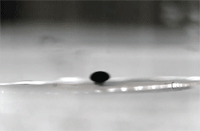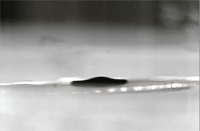A cutting-edge, implantable, electronic drug delivery device could be used to help treat macular damage caused by diabetic retinopathy (DR), according to a study in the August 21 issue of Lab on a Chip.



Time-elapsed images of the MEMS device releasing a dose of drug.
Researchers at the University of British Columbia evaluated the ability of an implantable, battery-less microelectromechanical system (MEMS) device to deliver on-demand dosages of the chemotherapy drug docetaxel to eyes with diabetic retinopathy.
Applying a magnetic field to the MEMS device triggers the release of a specific volume of docetaxel into the back of the eye—much like a flexible squirt bottle. The researchers determined that the MEMS device held its structural integrity for more than 35 days, with no clinically significant leakage.
“Technologies available now are either battery operated and are too large for treating the eye, or they rely on diffusion, which means drug-release rates cannot be stopped once the device is implanted—a problem when patients’ conditions change,” says study author Mu Chiao, Ph.D., associate professor at UBC and research chair in MEMS and nanotechnology for biomedical devices.
Still, several years of extensive testing will be required before the drug delivery system could be made available for patient use, the investigators say.
Pirmoradi FN, Jackson JK, Burt HM, Chiao M. On-demand controlled release of docetaxel from a battery-less MEMS drug delivery device. Lab Chip. 2011 Aug 21;11(16):2744-52.

